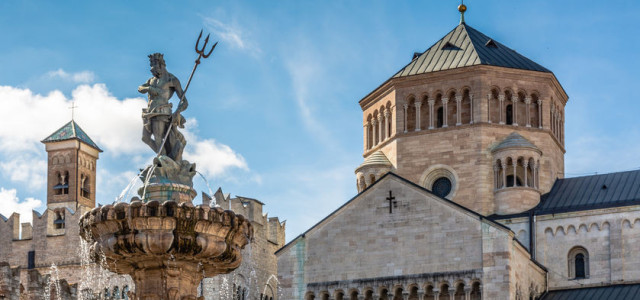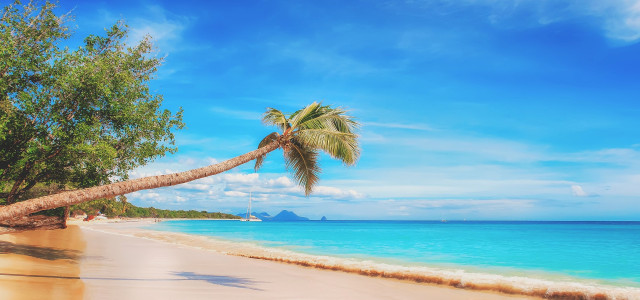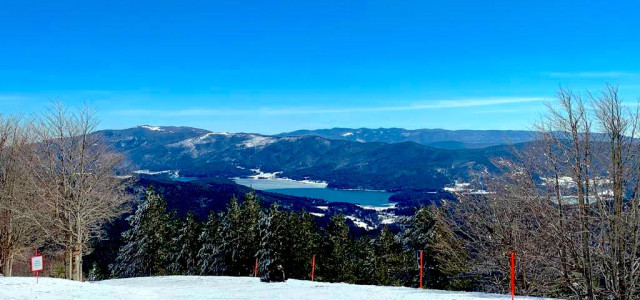Sulmona, Ovid’s birthplace
It's time to plan some nice weekend getaways! Or, better yet, a small vacation in some interesting place in Italy.
Summary
- What to see in Sulmona
- The entrance and Piazza Garibaldi
- Church of San Filippo Neri
- Former Monastery of Santa Chiara
- The aqueduct
- Church of San Rocco
- San Francesco della Scarpa
- San Panfilo
- The Complex of the Annunciation
- The Civic Museum of Sulmona
- How to get to Sulmona
- But how can we reach the city?
Let’s escape the stress and the frenzy that affects us every day. There are so many places to visit the hardest part will be making a decision. Today, however, we want to talk about Sulmona which is a historical city in Abruzzo that is located in the province of L'Aquila.
Its notoriety is mainly due to the fact that it is considered the Umbrian homeland of the Jordan almond, as well as being the birthplace of the poet Ovid. These are already valid enough reasons to expand our curiosity and choose it among the destinations to visit as well as to admire its beauty live ...
What to see in Sulmona
The entrance and Piazza Garibaldi
The first thing that will welcome you once you reach Sulmona is its splendid entrance way. Once we go beyond it, we will find ourselves immersed in the heart of the city. There we will find Piazza Garibaldi which is famous for being among the largest in Italy, and because the prestigious Fontanone made of Majella limestone is found there.
The square is also renowned because several traditional events take place there, such as: the Giostra Cavalleresca in which typical medieval games are played. These games are accompanied by a historical procession, where each participant marches wearing the typical clothes from the Renaissance tradition. In the same square, the rite of the Madonna that runs away is also celebrated. It recalls the episode in which the Madonna who was dressed in mourning clothes, begins to run after seeing her resurrected son.
Church of San Filippo Neri
On the east side of Piazza Garibaldi you will find the Church of San Filippo Neri that was built in 1677 with the original structure dating back to 1315. Originally, it housed the order of the Augustinian monks. When the church was rebuilt, the Gothic portal that characterized its entrance was rebuilt. The building suffered great damages due to the earthquake of 1706, but it was then rebuilt in 1785. The renovation was terminated a few years later on the occasion of the visit by Ferdinand IV of Bourbon.
Former Monastery of Santa Chiara
A little further away from the Church of San Filippo Neri, the former Monastery of Santa Chiara is located. It originally dates back to 1200, and took on the appearance of a typical Baroque church after its renovation. The complex lost its religious role and became a college in 1866 and currently hosts the Diocesan Museum of Sacred Art. Inside the structure you will find the Municipal Picture Gallery which is very intriguing and interesting to visit. Every year is hosts the contemporary art exhibition.
The aqueduct
Sulmona is also famous for its monumental aqueduct that was built in 1256 by Manfredi who was the son of Frederick II of Swabia. The structure has 21 round arches that are made up of white Maiella stone, and wind sinuously for a long stretch inside the city. It was built in order to transport water more easily from the mountain of Pacentro to the Piana di Peligna. Over the centuries, it underwent several changes and downsizing due to earthquakes that occurred in the area. Currently, it is no longer used for this purpose but still stands proud and powerful and reminds us of to the magnificence of the engineering from that time.
Church of San Rocco
As we enter the city, we come across the small church of San Rocco which is a building of modest size. It served as a meeting place for the three mayors of Sulmona. The building was donated by Queen Joanna of Aragon to the Holy House of the Annunciation. A rather interesting and particular fact is that the Queen who was madly in love with the city, wanted to become the Princess of Sulmona.
San Francesco della Scarpa
The city center is characterized by the Church of San Francesco della Scarpa that was built in 1291. It is part of a rather large monastic complex and is considered, amongst other things, the seat of the most important Franciscan order in Abruzzo. When it was built, it had a rather complex composition which remained in force until the earthquake of 1706. After that catastrophic event, the church was rebuilt in Baroque style and has a greatly simplified planimetric layout. The peculiarity of this building lies in its multitude of styles that are manifested in the various works contained within it, such as: the Baroque choir; the stuccos of the 700s; a crucifix dating back to the 1400s; and the Pala della Visitazione that created by the artist Giovanni Paolo Olmo; as well as several other works depicting various saints of considerable interest.
San Panfilo
As we visit the various churches which are scattered around the city, we cannot fail to explore the Cathedral of San Panfilo and admire its marvelous crypt that dates back to the 11th century. The current structure is the result of an overlap of different styles and architectures that was built over the centuries. The original building, originally dedicated to Santa Maria, was built in 1075 on the basis of an ancient Roman temple, according to the tradition from that period. It underwent several changes in the 12th century and was dedicated to the patron saint of the city. After the earthquake of 1706 the church was rebuilt in Baroque style. Currently, however, the only visible forms are those from the original Gothic structure.
The Complex of the Annunciation
The complex of the Annunziata is short distance from the Cathedral and is composed of the Palace that takes its name from it, the Church, and the Fontana del Vecchio. The palace was built in the Baroque period, and originally served as a hospital for pilgrims. The church was built during a later period - in the 15th century. Very little remains from the original structure, including the monumental bell tower located at the rear of the church. The complex interior was rebuilt after the earthquake of 1706, although some original Baroque elements were maintained, such as: the façade of the Palazzo Annunziata which has an ogival-shaped portal in which there are several figures that are hilighted, including the statue of St. Michele Arcangelo. Inside the Palace, the Civic Museum of Sulmona is housed which is another place of particular historical and artistic interest, and which you should absolutely not miss.
The Civic Museum of Sulmona
Due to the fact that we now find ourselves in the Complex of Santa Annunziata, a visit to the Civic Museum of Sulmona is definitely worth our time. It is the last attraction of the city that we absolutely must see. Here we must spend a bit of our time exploring the different collections that are preserved inside, including many archaeological finds and various objects that are typical of the Umbrian tradition. The museum is spread out over 10 different rooms, 4 of which are dedicated to archaeological finds including the remains of an ancient Roman domus. The other six rooms (from 5 to 10) house the Pinacoteca, where important artistic works by painters and sculptors such as Giovanni da Sulmona, Giuseppe Simonelli, Giuseppe Crescenzio and many others from the 13th to the 18th century are kept. Among other things you can admire works of goldsmithing, precious fabrics, sculptures, paintings by unknown artists and a splendid collection of clothes and costumes of the Abruzzese tradition, preserved in the adjacent museum dedicated specifically to them.
How to get to Sulmona
But how can we reach the city?
By car
The first alternative that we have is by car, a comfortable vehicle that allows us to move freely and Independently. Whether you come from the north or from the south, the first road to take is the A14. In the first case you have the option take the exit for Ancora, in the second one the exit for Pescara. You can then continue towards Rome until you reach the A25 and exit at Bussi / Popoli and continue towards L'Aquila, taking the A24. Finally you will have to take the SS17 towards Popoli and follow the signs that will lead you to Sulmona.
By Train
The train is certainly a convenient means of transportion, allowing you to enjoy the journey while being comfortably seated, and to better yet to observe the sights. If you choose this method of transportation, you have the option to choose between three different lines: - the Rome - Pescara Line; the Sulmona - Naples Line; and the Sulmona - Terni Line. You can consult the train timetables and fares by visiting the Ferrovie dello Stato website, and get an idea of how long it will take to arrive, in order to better plan you journey.
By Bus
There are also cheaper and more convenient means than by train, even if these methods are slower. The bus is one of these options. You can choose different transport lines, it all depends from our starting point. If you come from Rome, the bus line that leads to Sulmona is the Schiappa Bus Line which departs from Tiburtina. From Naples instead, you can choose either the ARPA (Autolinee Regionale Pubbliche Abruzzesi) Autolinee or the Autolinea Satam. The latter is also based in Bologna, and if you start from this city, Satam is your bus line of reference
By Plane
Sulmona can also be reached by plane via the Airports of Pescara, Rome Ciampino, Rome Fiumicino and Naples. Although it is the fastest means of transportion, the cost of the ticket will be greater than that of the train and bus, and you will not have the opportunity to admire the wonderful sights during the journey.
By Ship
Finally the last means of transportion you can use is the ship. Departures take place from the port of Pescara which is 69km from Sulmona; from the Port of Naples which is 156 km away, and from Rome which is 185 km away. For departure times and fares you can visit the website of each port.
Reproduction reserved © Copyright Altrama Italia
![Immagine descrittiva - BY [Claudio Giovanni Colombo/123rf] Immagine descrittiva - BY [Claudio Giovanni Colombo/123rf]](https://api.viaggiart.com/resources/images/xl/list/image/171181-3571fffbb6aa56ad9931fe64c6df54cc-1560779692.jpg)






